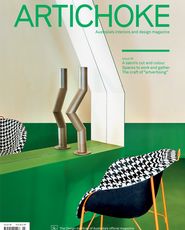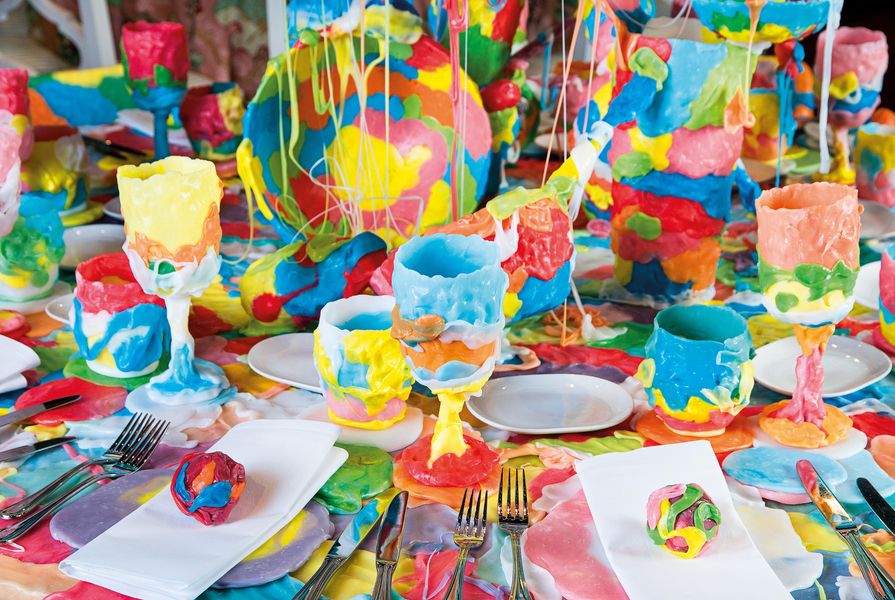For just three days in May 2016, the National Gallery of Victoria’s Great Hall was transformed into a veritable smorgasbord of decorated table settings by Australia’s artistic and design elite. The exhibition, dubbed Best of the Best, is the brainchild of the NGV Women’s Association and raised funds for the acquisition of artworks for the NGV.
The first iteration of Best of the Best was held in 2013 at the St Kilda Town Hall. Back by popular demand in 2016, the exhibition included more than forty table settings created by some of Australia’s leading artists, designers and creatives, as well as exhibitors outside the fine arts, including the Australian Ballet, Australian Football League, and dessert aficionados Burch and Purchese Sweet Studio. For the hungry and financially generous, a black-tie charity dinner treated guests to a live performance of the table centrepieces.
Food and culture were obvious themes with many of the centrepieces provocatively reflecting both historical and contemporary society. Artistically, they sat somewhere between a debaucherous Roman feast and a Heston Blumenthal creation.
Russell & George’s table was based on reflections and featured a large convex mirror centrepiece.
Image: courtesy photographic services National Gallery of Victoria.
Melbourne architecture and design practice Russell & George’s elegantly simple table setting was literally reflective. “The table arrangement consists of a large convex mirror centrepiece, reflecting and distorting the Great Hall and its environs,” stated the interior design studio. The surface of the table is also reflective, providing two different views of the Great Hall’s iconic ceiling by artist Leonard French.
Melbourne-based creative studios Flack Studio and Marsha Golemac set the table with a PoMo-looking arrangement inspired by two great twentieth-century designers, Ettore Sottsass and Shiro Kuramata. The arrangement of primary coloured, geometric objects “talk to each other through a relation of juxtaposition and a celebration of the ugly-beautiful,” the designers stated. The objects sat atop a clear tabletop “so its users can observe any hanky-panky that takes place under the table during dinner.”
The “ugly-beautiful” also made an appearance in designer Dale Hardiman’s table setting, which he described as “a vulgarity of free-form design” made from “colourful globules of bubblegum.” It’s as if the table was decorated by a certain insufferable, chewing gum-obsessed Charlie and the Chocolate Factory character as a punishment for touching things she shouldn’t. The entire table setting, including the plates, cutlery, vases and even chairs, was made from hand-moulded riotous candy-coloured plastic, which is bio- degradable and food safe. It’s a pity Hardiman’s Polly Popper lamp, which is made from the same material and was designed with Andre Hnatojko in 2013, wasn’t hanging from the ceiling.
Created by Jud Wimhurst for Mars Gallery, the “Sugar coated” table was a sweet and sugary allegory to the “scary things” in life.
Image: courtesy photographic services National Gallery of Victoria.
Sticking with the candy theme, the table setting by Jud Wimhurst for Mars Gallery featured a pile of oversized gummy lollies shaped like guns, hand grenades and snakes. Titled Sugar Coated: Life can be confronting , the installation was an uncomfortable juxtaposition of the innocence of sweets and the “scary things that may be lurking around the corner,” as the artist described. “But as long as they look sweet and are drenched in sugar, we’re happy to swallow just about anything.”
Perhaps the most provocative table of all, for the dinner guests at least, was Julia deVille’s centrepiece, which featured “a taxidermy lamb displayed on an antique platter with a ruby wound dripping from his neck,” as described by the artist. “I am encouraging all guests seated at the table to reflect on the theme and consider a vegan/vegetarian practice.” These are hard-to-swallow words, especially challenging for any diners at the event who had just ingested the saltbush lamb canapé and were about to tuck into the Gippsland Angus beef for the main course.
The money raised from the first Best of the Best exhibition contributed towards the acquisition of The Young Mother (1897) by John Longstaff. As an exhibition concept, it certainly is an appropriate application of the l’art pour l’art philosophy.
Source

Discussion
Published online: 22 Nov 2016
Words:
Linda Cheng
Images:
Brooke Holm,
courtesy photographic services National Gallery of Victoria.
Issue
Artichoke, September 2016


























